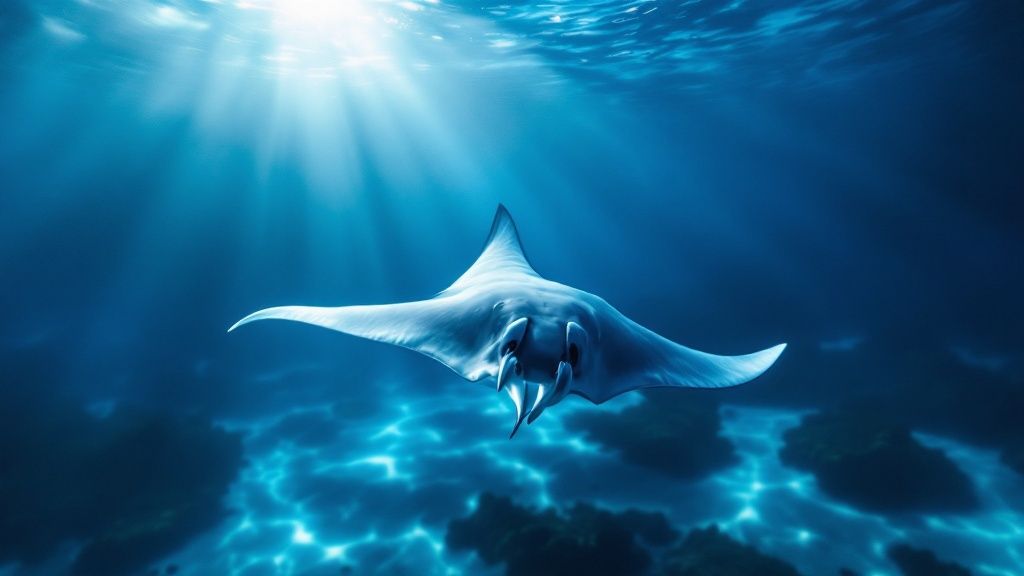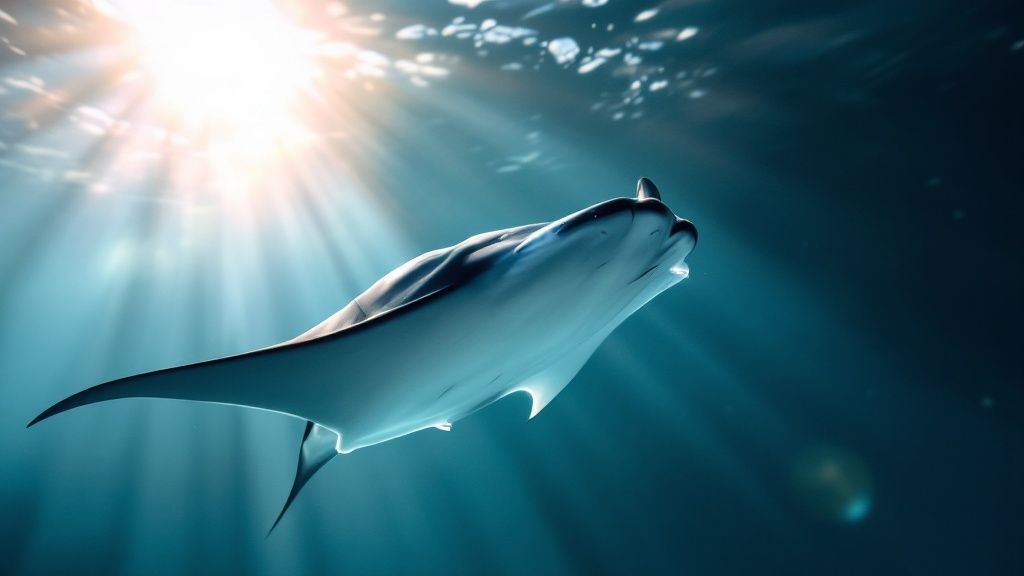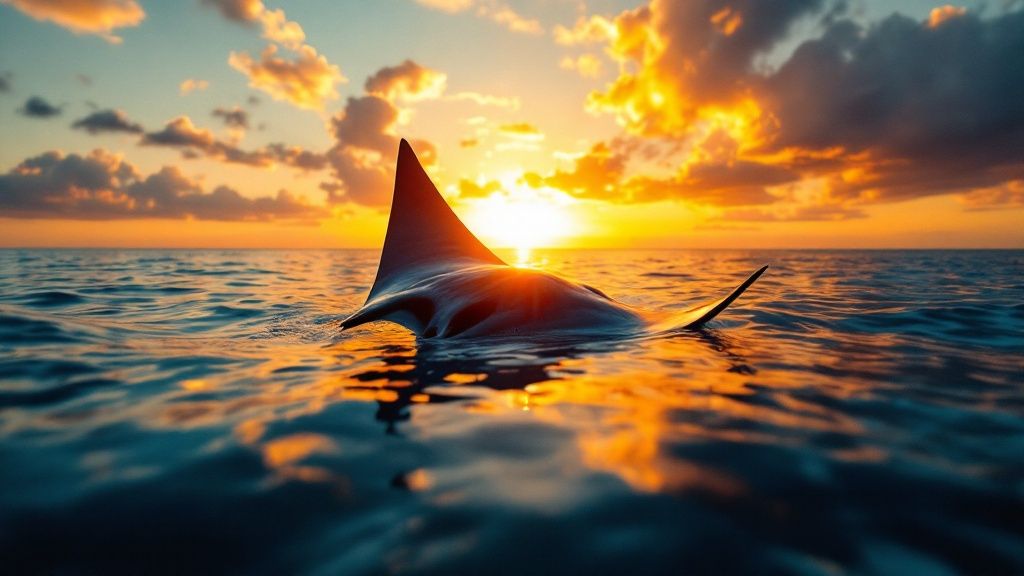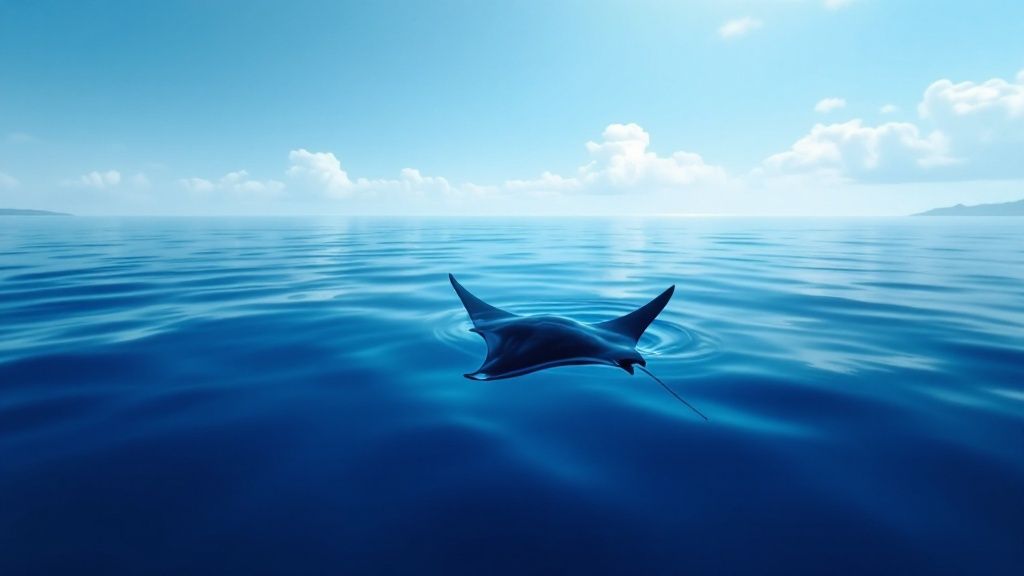Manta Ray Kona Hawaii: Into the Underwater Night Ballet
- Byron
- Mar 22
- 11 min read
The Mesmerizing Dance of Kona's Manta Rays

Imagine floating in the dark Pacific Ocean, under a blanket of stars. Suddenly, a shape emerges from the depths, growing into a 16-foot manta ray gliding beneath you. This is the magic of a manta ray night snorkel in Kona, Hawaii. It's an experience frequently described as life-changing.
The Kona Manta Ray Experience: A Bucket-List Adventure
People travel from all over the world to experience the thrill of interacting with these gentle giants. Kona's night waters provide the perfect setting for close encounters, unlike any other wildlife experience. Anticipation builds as darkness falls, turning the ocean into a mysterious world. Then, as if on cue, the majestic manta rays appear, their movements creating a breathtaking underwater ballet.
Why Kona? The Perfect Combination of Conditions
Kona offers a unique combination of factors that make it ideal for these nighttime interactions. The volcanic slopes of the Big Island create deep offshore waters rich in plankton, the mantas' primary food source. The calm, clear waters provide excellent visibility.
This ecosystem has made manta ray viewing a cornerstone of Kona's tourism. Manta rays have been a central attraction in Kailua-Kona for decades. Local outfitters estimate that roughly 80,000 people come to snorkel and dive with manta rays annually, making it a significant economic driver. This popularity comes from the unique experience of observing these creatures up close, particularly at night. Learn more about the cultural significance of manta rays: The Cultural Significance of the Manta Ray in Hawaii. You can also explore our blog post sitemap for further reading.
From Anticipation to Awe: What to Expect
The experience begins with a boat trip to a designated manta viewing area. As darkness descends, spotlights are placed in the water to attract plankton. This draws the manta rays, creating a mesmerizing display as they perform acrobatic barrel rolls to feed. Their unique white belly markings allow researchers and guides to identify them, adding a personal touch. This means you could see the same manta ray more than once! Observing these gentle giants up close is exhilarating and offers a chance to connect with one of the ocean's most remarkable creatures.
From Accidental Discovery to World-Class Attraction

The story of Kona's manta ray night dives is a fascinating example of how a simple observation can blossom into a globally recognized ecotourism experience. It all began not with a grand scheme, but a stroke of pure luck. It’s a testament to human curiosity and the importance of responsible interaction with nature.
Hotel Lights and a Happy Accident
The now-famous manta ray viewing sites in Kona were a serendipitous discovery. In the 1970s, the Kona Surf Hotel’s shoreline floodlights inadvertently attracted plankton, the manta ray's primary food source. Initially, the connection between the lights, the plankton, and the gathering mantas wasn't obvious. This seemingly minor event laid the groundwork for what would eventually become a thriving industry.
Jim Robinson recognized this unique pattern in 1991. Seeing the potential for an extraordinary diving experience, he began organizing regular scuba night dives around this unexpected attraction. You can find more information about these tours on our sitemap. The growing popularity of these dives quickly highlighted the need for structured interactions to protect both the manta rays and the divers. For further details on Kona’s unique viewing locations, check out Manta Ray Viewing Sites in Kona, Hawaii.
The Birth of an Industry and Conservation Efforts
The influx of divers eager to see these gentle giants led to the development of marine interaction guidelines. These guidelines aimed to minimize disturbances to the manta rays while ensuring a safe and enriching experience for visitors. This proactive approach represented a crucial step in balancing economic opportunities with environmental protection.
As the industry expanded, so did our understanding of manta ray behavior. The discovery of new viewing sites, like Manta Heaven, further diversified the manta ray tourism experience.
Cultural Significance and Responsible Tourism
In Hawaiian tradition, manta rays hold a position of reverence. They are seen as graceful and intelligent creatures, embodying the spirit of the ocean. This cultural respect played a significant role in shaping responsible tourism. Local knowledge, combined with scientific research, informed the implementation of sustainable viewing protocols. These protocols have helped make Kona a model for manta ray ecotourism worldwide.
The harmonious blend of cultural reverence and economic opportunity in Kona offers a rare conservation success story. It demonstrates how protecting these magnificent creatures can work in tandem with sharing their wonder with the world.
The Secret Lives of Hawaii's Gentle Giants
Manta rays are more than just graceful dancers in Kona's moonlit waters. These gentle giants have fascinating biology and complex behaviors. Let's explore the intricate world of these incredible creatures and deepen your appreciation for them.
Decoding Manta Ray Behavior
On Kona night dives, you'll see some distinctive manta ray behaviors. One of the most captivating is the barrel roll feeding technique. Mantas perform mesmerizing spirals, effectively funneling plankton-rich water into their mouths.
This feeding strategy maximizes their intake of these microscopic organisms, their primary food source. Another remarkable behavior is their navigation in near darkness. These massive creatures demonstrate impressive precision.
They use a combination of sensory systems to locate their feeding grounds with incredible accuracy. For more fascinating information about marine life, check out our blog post sitemap.
The Significance of Belly Patterns
Just like human fingerprints, each manta ray has a unique belly pattern. Researchers and local guides use these markings to identify individual mantas, often giving them names.
This identification is crucial for tracking their movements and understanding their social dynamics. This means that during your manta ray Kona, Hawaii experience, you might see the same manta multiple times, adding a personal connection to your observations.
Size, Lifespan, and Conservation
Manta rays can grow to enormous sizes, with some reaching up to 23 feet wide and weighing over 3,000 pounds. Despite their size, they are gentle creatures that feed exclusively on plankton. This makes them safe for tourists to observe in their natural habitat.
Their average lifespan is estimated to be between 20 and 30 years, though some live up to 40 years. Manta rays are slow-growing and reproduce infrequently, highlighting the importance of conservation efforts. Learn more about this: Why Manta Rays Are One of the Coolest Animals in the World.
Social Dynamics and Intelligence
Manta rays exhibit compelling social interactions. They often gather in groups at feeding sites, suggesting a degree of social structure. Research also indicates that manta rays possess surprising intelligence.
They’ve demonstrated an ability to learn and adapt, even exhibiting individual personalities recognized by researchers. Understanding these behavioral nuances elevates a manta ray Kona, Hawaii encounter from simple observation to a meaningful connection with these extraordinary ocean inhabitants. This deeper appreciation enriches your experience and fosters respect for these gentle giants.
Prime Manta Ray Viewing Locations in Kona
Not all manta ray viewing sites are created equal. Knowing the nuances of each location can significantly improve your chances of an unforgettable manta ray encounter. This guide explores Kona's top manta ray spots, highlighting the unique benefits of each.
Manta Village: Easy Access and Reliable Sightings
Manta Village, nestled in Keauhou Bay, is famous for its easy access and frequent manta ray sightings. The relatively shallow, calm waters make it perfect for snorkelers and new divers. Its proximity to the shore minimizes travel time, giving you more time in the water with the mantas. This site is especially well-suited for families with children because of the shorter boat rides and calmer conditions. While it can get busy, particularly during peak season, the high number of manta rays usually ensures a close-up view.
Manta Heaven: Clear Waters and Larger Gatherings
North of Manta Village, near the airport, lies Manta Heaven. Known for its exceptionally clear water, this site sometimes attracts larger groups of manta rays. However, its offshore location means slightly longer boat rides. Manta Heaven is likely a better fit for experienced snorkelers and divers comfortable in deeper water. While the potential for seeing more mantas is appealing, remember that ocean conditions at Manta Heaven can be rougher depending on the time of year.
Hidden Gems: Intimate Encounters and Smaller Crowds
Beyond the popular spots, Kona offers a few lesser-known manta ray viewing locations. These hidden gems provide a more personal experience with far fewer people. While sightings aren't as consistent, the chance for a spectacular, nearly private encounter makes these locations worth considering. Check with local tour operators for more information about these secluded viewing areas and the best times to go. These spots can be perfect for experienced ocean enthusiasts looking for a unique adventure.
To help you choose the right spot, we've compiled a comparison table of the main viewing locations:
Kona Manta Ray Viewing Sites Comparison This table compares the main manta ray viewing locations in Kona, highlighting their unique features, accessibility, and sighting probability to help visitors choose the best option for their experience.
Viewing Site | Location | Best For | Access Method | Average # of Mantas | Special Features |
|---|---|---|---|---|---|
Manta Village | Keauhou Bay | Families, beginners | Short boat ride | 10-15 | Calm waters, easy access |
Manta Heaven | Near airport | Experienced snorkelers/divers | Longer boat ride | 15-20 (potential for more) | Pristine water clarity |
Hidden Gems | Varies | Private encounters, experienced ocean-goers | Consult local operators | Varies | Secluded, fewer crowds |
This table provides a quick overview of the main differences between Kona's manta ray viewing sites. Choosing the right spot can enhance your experience based on your skill level and desired level of interaction.
Factors Influencing Your Manta Ray Experience
Understanding the environmental factors that influence manta ray behavior can significantly increase your chances of a successful sighting. The moon phase plays a vital role, as the plankton manta rays feed on are drawn to light during a new moon. Plankton blooms, affected by seasonal shifts in ocean currents and nutrient levels, also impact manta ray feeding habits. Speaking with local tour operators who understand these patterns will greatly benefit you when planning your manta ray Kona Hawaii adventure. They can advise on the ideal time of year and even the best time of day to maximize your chances of seeing these magnificent creatures.
Protecting Kona's Manta Ray Treasures

The magic of Kona's manta ray night dives is more than just a spectacle; it’s a testament to ongoing conservation work. The future of these encounters depends on a careful balance between tourism and protecting these gentle giants. Understanding these dynamics adds another layer of appreciation to your manta ray experience in Kona, Hawaii.
Balancing Tourism and Conservation
Manta ray tours in Kona are a real ecotourism success story. But maintaining this balance requires careful management. Limiting the number of boats and snorkelers at viewing sites, for example, minimizes disruption to the manta rays' natural feeding behaviors.
Educating visitors about responsible manta ray interactions is also crucial. This ensures these magnificent creatures are treated with the respect they deserve. It’s all about enjoying the experience while safeguarding their future.
Threats to Manta Ray Populations
While Kona's manta rays benefit from dedicated conservation, they still face threats globally. Overfishing, habitat degradation, and entanglement in fishing gear are serious concerns. Climate change also impacts the availability of plankton, their main food source.
The IUCN classifies both reef and giant manta rays, found in Hawaii, as vulnerable to extinction. While a healthy population of approximately 22,000 giant manta rays thrives in Ecuador, Hawaii's resident population is much smaller, around 130. Protecting these animals involves international trade regulations, marine protected areas, and raising public awareness. Learn more about manta ray conservation here. You can also explore other blog posts on our site here.
Research and Citizen Science
Innovative research is vital for understanding and protecting manta rays. Photo identification, using the unique spot patterns on each manta's belly, allows researchers to track individuals. This provides valuable data about their movements, population size, and social interactions.
Citizen science initiatives further enhance this research. Divers and snorkelers can contribute their underwater photos to databases, expanding scientific knowledge. This participatory approach empowers individuals to become active participants in conservation efforts.
Community-Led Initiatives: A Model for Success
Kona is a global example of successful community-led conservation. Local initiatives have established protected areas and sustainable viewing practices. These locally driven efforts have been remarkably effective.
This success demonstrates the power of collaboration between communities, tour operators, and researchers. Kona's model is now being replicated worldwide, showcasing its leadership in manta ray conservation. This collaborative spirit ensures these amazing encounters will be possible for generations to come.
Crafting Your Perfect Manta Ray Kona Hawaii Adventure

Turning your dream of a manta ray encounter into a reality takes planning. This guide offers insider tips to help you create the perfect Kona, Hawaii manta ray experience, going beyond the usual travel advice. We'll give you the knowledge to make smart choices that maximize your enjoyment while respecting these amazing creatures.
Snorkeling Vs. Scuba: Choosing Your Adventure
Your first decision is how you want to experience the manta rays: snorkeling or scuba diving. Snorkeling is an accessible option, perfect for families and those new to water activities. It requires minimal equipment and lets you float on the surface, watching the mantas from above.
Scuba diving, on the other hand, offers a more immersive experience. Certified divers can get a closer look, experiencing the manta rays' world from their perspective. This requires proper PADI certification and being comfortable in deeper water. Both options offer incredible views; the best choice depends on your comfort level and experience goals.
Enhancing Your Tour: Essential Elements Vs. Add-Ons
Many tour operators offer add-ons, but it's important to separate the essential elements from the unnecessary extras. A small group size is key for a more personal encounter, minimizing disturbance to the mantas and maximizing your interaction time. Experienced, lifeguard-certified guides add a layer of safety and provide valuable insights into manta ray behavior.
While some tours offer food or longer durations, these are often less important than the core elements of a positive manta ray experience. Focus on finding operators with strong conservation credentials who prioritize respectful interactions. Want to learn more? Check out our guide on various marine life topics.
Practical Preparation: Ensuring a Smooth and Enjoyable Experience
Thorough preparation will enhance your enjoyment and minimize potential discomfort. Seasickness can affect your experience, so consider seasickness prevention strategies like medication or ginger remedies. Practicing with your snorkel gear beforehand, especially if you’re a beginner, will increase your confidence in the water.
For underwater photography, use responsible techniques that respect manta ray behavior, avoiding flash photography, which can startle them. Understand the water conditions and the quality of equipment offered by different operators. Check for accessibility options if needed. Addressing these practical considerations will let you approach your manta ray encounter with confidence and excitement.
Addressing Common Concerns
Many first-timers have questions about water conditions, equipment quality, and what to expect. Water temperatures in Kona are generally comfortable, but many operators offer wetsuits for extra warmth. This is particularly helpful for night tours, as the water can feel cooler after sunset. Inquire about the quality of the provided snorkel gear to ensure a comfortable and secure fit.
While manta rays are often seen in Kona, they are wild animals. Reputable tour operators often offer a "manta guarantee," allowing you to rebook if you don't see any mantas on your first trip. This reassurance can alleviate concerns about a potentially unsuccessful sighting.
Choosing The Right Tour For You
With so many tour operators offering manta ray night snorkels in Kona, finding the right one can be tough. Consider your budget, desired group size, and the operator’s commitment to sustainable practices. Reviews and testimonials can offer valuable insights into past experiences.
The following table, "Manta Ray Tour Options and Pricing," presents the different types of manta ray tours available in Kona. This overview of typical duration, price ranges, and inclusions will help you find the best option for your budget and preferences.
Tour Type | Duration | Price Range | Group Size | Experience Level | What's Included | Best For |
|---|---|---|---|---|---|---|
Basic Snorkel Tour | 1.5-2 hours | $100-$150 | 10-20 | Beginner | Snorkel gear, wetsuit, guide | Budget-conscious, first-timers |
Deluxe Snorkel Tour | 2-3 hours | $150-$250 | 6-12 | Beginner to Intermediate | Snorkel gear, wetsuit, guide, snacks/drinks | Enhanced comfort, small group experience |
Private Charter | Customizable | $500+ | Customizable | All levels | Snorkel gear, wetsuit, dedicated guide, personalized itinerary | Families, special occasions |
Scuba Diving Tour | 2-3 hours | $150-$250 | 4-8 | Certified Divers | Dive gear, guide | Experienced divers |
As you can see, there's a manta ray tour for everyone. From budget-friendly options to private charters, the key is to find what suits your needs.
Ready to book your incredible manta ray night snorkel experience? Visit Manta Ray Night Snorkel Kona Hawaii Tours and embark on an unforgettable adventure.
Comments